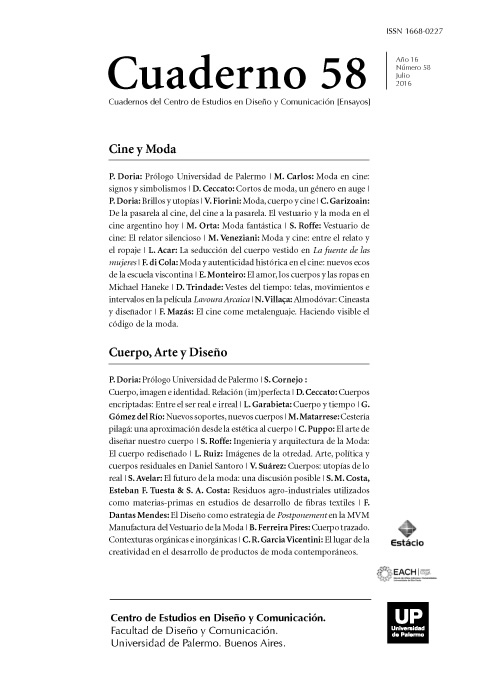Cuerpos encriptados: entre el ser real e irreal
Abstract
This paper addresses the issue of the treatment of the body in three works of Nicola Costantino: Peletería Humana, Savon de corps and Trailer. Body Art was the first in taking the body as a working material (from the sixties and seventies in the 20th century).
Later, in the nineties, there was a return to the body in art, referring to his ability to be a real object and, at the same time a symbolic one. With new practices carried out by the artists, several concepts, as carnal art (proposed by Orlan), new meat and posthumanism were introduced. This latter view means that the human body nature -the corporeal- has been changed. From this vision, is no necessary to scan under the skin or in the unconscious (as in body art) but, after Ivan Mejias, “ask about the new experiences that modify and sculpt the body, such as cosmetics, light food, cosmetic surgery ... “. Thus, the bodies are encrypted through different operations. The encryption term comes from computing and means the process to transform important information in unreadable information which has to be decoded by a password. The body is a significant matter and takes different meanings; although it is the body itself, which carries it real “information” of itself.
References
Aumont, J. (1992). La imagen. Barcelona: Paidós.
Bourriaud, N. (2009). Radicante. Buenos Aires: Adriana Hidalgo Editora.
Danto, A. (2003). Después del fin del arte: el arte contemporáneo y el linde de la historia. Barcelona: Paidós.
Estañol, B. El doble, texto publicado en Revista de la Universidad de México. Disponible en: http://www.revistadelauniversidad.unam.mx/6509/pdfs/65estanol.pdf. Consultado en agosto de 2011.
Heinch, N. (1998). Las fronteras del arte contemporáneo: entre esencialismo y constructivismo, texto presentado en el Coloquio “Las fronteras estéticas del arte”, Université Paris- Lyon VIII, y publicado en Les Frontierés esthétiqus de l´art, París, L´harmattan, 1999.
Lamizet, B. (2004). Semiótica de la lectura. Texto original del francés Sémiotique de la Lecture. Traducción de Susana Arroyo-Furphy. Disponible en: http://www.razonypalabra.org.mx/anteriores/n38/blamizet.html
Lipovetsky, G. (1987). El Imperio de lo Efímero. La Moda y su Destino en las Sociedades Modernas. España: editorial Anagrama.
Mejía, I. (2005). El cuerpo posthumano en el arte y la cultura contemporánea. México: Coordinación de publicaciones ENAP-UNAM.
Navarro, J. (2002). La Nueva Carne: una estética perversa del cuerpo. Madrid: Valdemar.
Prada, J. M. (2001). La apropiación posmoderna: arte, práctica apropiacionista y teoría de la posmodernidad. Madrid: Ed. Fundamentos.
Saulquin, S. (2010). La muerte de la moda, el día después. Buenos Aires: Paidós.
Trosman, C. (2006). Orlan: El Arte Carnal y la ruptura del concepto social de cuerpo. Disponible en: http://www.topia.com.ar/articulos/orlan-el-arte-carnal-y-la-ruptura-del-concepto-social-de-cuerpo
Los autores/as que publiquen en esta revista ceden los derechos de autor y de publicación a "Cuadernos del Centro de Estudios de Diseño y Comunicación", Aceptando el registro de su trabajo bajo una licencia de atribución de Creative Commons, que permite a terceros utilizar lo publicado siempre que de el crédito pertinente a los autores y a esta revista.


